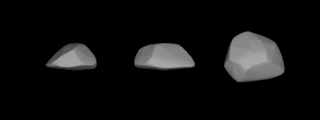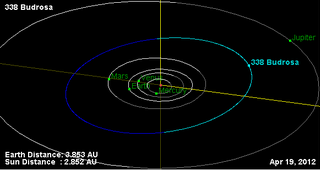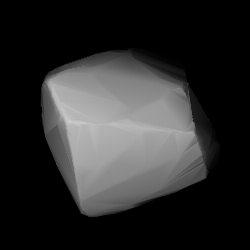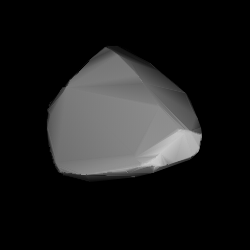
Althaea is a main-belt asteroid that was discovered by Canadian-American astronomer J. C. Watson on April 3, 1872, and named after Althaea, the mother of Meleager in Greek mythology. Two occultations by Althaea were observed in 2002, only a month apart.

Budrosa is a large Main belt asteroid. It is classified as an M-type asteroid. It was discovered by Auguste Charlois on 25 September 1892 in Nice.

343 Ostara is a background asteroid from the inner region of the asteroid belt. It was discovered by German astronomer Max Wolf at the Heidelberg Observatory on 15 November 1892.

361 Bononia is a very large, resonant Hilda asteroid located in the outermost region of the asteroid belt. It is classified as a D-type asteroid and is probably composed of organic rich silicates, carbon and anhydrous silicates. It was discovered by Auguste Charlois on 11 March 1893, in Nice, and assigned the prov. designations A893 EF and 1893 P.

394 Arduina is an asteroid from the central regions of the asteroid belt. It was discovered by A. Borrelly on 19 November 1894 in Marseilles.

Sigune is a minor planet, specifically an asteroid orbiting primarily in the asteroid belt. Like 501 Urhixidur and 500 Selinur, it is named after a character in Friedrich Theodor Vischer's then-bestseller satirical novel Auch Einer.

Iolanda is a minor planet orbiting the Sun.

Nassovia is a minor planet orbiting the Sun. It is a member of the Koronis family of asteroids.

621 Werdandi is a Themistian asteroid.
623 Chimaera is a minor planet, specifically an asteroid orbiting in the asteroid belt.
625 Xenia is a minor planet orbiting the Sun. It was discovered by August Kopff in Heidelberg, Germany, on 11 February 1907. The name may have been inspired by the asteroid's provisional designation 1907 XN.
637 Chrysothemis is a Themistian asteroid.
646 Kastalia is a minor planet orbiting the Sun, not to be confused with the near-Earth asteroid 4769 Castalia.

662 Newtonia is a minor planet, specifically an asteroid orbiting mostly in the asteroid belt.
667 Denise is a minor planet orbiting the Sun. The name may have been inspired by the asteroid's provisional designation 1908 DN.
668 Dora is an asteroid orbiting in the asteroid belt located roughly between the orbits of the planets Mars and Jupiter. The name may have been inspired by the asteroid's provisional designation 1908 DO.
768 Struveana is a minor planet orbiting the Sun. The asteroid was named jointly in honor of Baltic German astronomers Friedrich Georg Wilhelm von Struve, Otto Wilhelm von Struve and Karl Hermann Struve.

852 Wladilena is a Phocaea asteroid from the inner region of the asteroid belt. It is named after the Russian Communist leader Vladimir Lenin.
872 Holda is a minor planet orbiting the Sun.

915 Cosette is an S-type asteroid belonging to the Flora family of Main Belt asteroids. Its rotation period is 4.445 hours.












